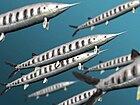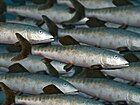Cooyoo

| Cooyoo Temporal range: | |
|---|---|
 | |
| Reconstruction according to specimen "Wandah" | |
| Scientific classification | |
| Domain: | Eukaryota |
| Kingdom: | Animalia |
| Phylum: | Chordata |
| Class: | Actinopterygii |
| Order: | †Ichthyodectiformes |
| Family: | †Ichthyodectidae |
| Genus: | †Cooyoo Bartholomai & Lees,[1] 1987 |
| Species: | †C. australis |
| Binomial name | |
| †Cooyoo australis (Woodward, 1894) | |
| Synonyms | |
| |
Cooyoo ("fish" in the Yirandhali language) is an extinct genus of ichthyodectid fish known from the Lower Cretaceous. It contains a single species, C. australis, known from the Albian-aged Toolebuc and Allaru Formations of Queensland, Australia.[1] C. australis was originally named by Arthur Smith Woodward as a species of Portheus (now a probable synonym of Xiphactinus) in 1894, which was later amended to Xiphactinus.[1]
Some phylogenetic studies have recovered it as an indeterminate ichthyodectiform, but later ones have found it to either be a sister of Unamichthys, or more recently a true ichthyodectid related to Ichthyodectes.[2][3][4][5]
Cooyoo was a dominant predator of the Eromanga Sea.[5] As with all other ichthyodectids, it was a predator of smaller fish, and had large conical teeth to easily catch them.[6] In contrast, Cooyoo itself was a prey item for larger animals, as a skull has been found with potentially fatal bite marks, which are referable to a polycotylid plesiosaur, an ornithocheiroid pterosaur, or most likely the ichthyosaur Platypterygius.[7]
Cooyoo was initially described from a complete specimen with length about 1.1 metres (3.6 ft),[1] and other fossil remains have been found including near-complete skulls.[6][8] In 2011, a 2.5 metres (8.2 ft) long intact fossil, nicknamed "Wandah", was discovered in north-west Queensland. According to Rob Levers, Kronosaurus Korner museum founder and chairman, it was possible to detect the fish in the stomach of that specimen. Cooyoo is the largest bony fish known from the Eromanga Sea.[9][10]
References
[edit]- ^ a b c d Bartholomai; Lees (1987). "Cretaceous actinopterygian (Class Pisces) Cooyoo australis from Queensland". Memoirs of the Queensland Museum.
- ^ Cavin, Lionel; Forey, Peter L.; Giersch, Samuel (2013). "Osteology of Eubiodectes libanicus (Pictet & Humbert, ) and some other ichthyodectiformes (Teleostei): phylogenetic implications". Journal of Systematic Palaeontology. 11 (2): 115–177. doi:10.1080/14772019.2012.691559. ISSN 1477-2019.
- ^ Yabumoto, Yoshitaka; Hirose, Koji; Brito, Paulo M. (2020-03-15). "A new ichthyodectiform fish, Amakusaichthys goshouraensis gen. et sp. nov. from the Upper Cretaceous (Santonian) Himenoura Group in Goshoura, Amakusa, Kumamoto, Japan". Historical Biology. 32 (3): 362–375. doi:10.1080/08912963.2018.1497022. ISSN 0891-2963.
- ^ Cavin, Lionel; Berrell, Rodney W. (2019-01-02). "Revision of Dugaldia emmilta (Teleostei, Ichthyodectiformes) from the Toolebuc Formation, Albian of Australia, with comments on the jaw mechanics". Journal of Vertebrate Paleontology. 39 (1): e1576049. doi:10.1080/02724634.2019.1576049. ISSN 0272-4634.
- ^ a b Berrell, Rodney W.; Boisvert, Catherine; Trinajstic, Kate; Siversson, Mikael; Alvarado-Ortega, Jesús; Cavin, Lionel; Salisbury, Steven W.; Kemp, Anne (2020-04-02). "A review of Australia's Mesozoic fishes". Alcheringa: An Australasian Journal of Palaeontology. 44 (2): 286–311. doi:10.1080/03115518.2019.1701078. ISSN 0311-5518.
- ^ a b Robertson, Joshua (2015-07-17). "100 million-year-old fossils shed new light on Australia's ancient inland sea". The Guardian. ISSN 0261-3077. Retrieved 2024-06-12.
- ^ Wretman, Lovisa; Kear, Benjamin P. (2014-04-03). "Bite marks on an ichthyodectiform fish from Australia: possible evidence of trophic interaction in an Early Cretaceous marine ecosystem". Alcheringa: An Australasian Journal of Palaeontology. 38 (2): 170–176. doi:10.1080/03115518.2014.848692. ISSN 0311-5518.
- ^ "Fossils of giant fish unearthed in outback Qld". ABC News. 2015-07-17. Retrieved 2024-06-12.
- ^ "Kronosaurus Korner - Fish". www.kronosauruskorner.com.au. Retrieved 2023-07-06.
- ^ "Tourists unearth 100 million-year-old marine predator in western Queensland". ABC News. 2023-02-28. Retrieved 2023-03-03.






